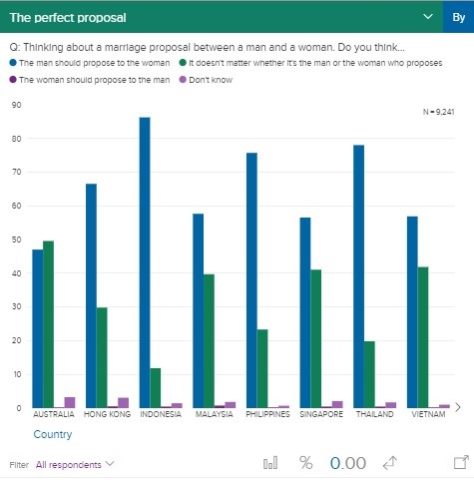New research also shows half of respondents believe an engagement ring should cost at least one month’s salary
What makes the perfect proposal? The latest research from YouGov, the world’s leading online research firm, reveals that traditions still hold strong across the Asia-Pacific. However, while many still prefer tradition, new and emerging norms are being embraced by many across the region.

Half of Australians say it doesn’t matter which gender proposes
Across APAC, two-thirds (66%) of respondents believe a man should propose to a woman, though this varies hugely between countries. The belief is most widely held in Indonesia (86%), Thailand (78%), and Philippines (76%). By contrast, Australians are the most relaxed; half of those polled (50%) say it doesn’t matter whether it’s the man or woman who proposes.
Though most respondents have a strong preference for the man to propose, three-quarters (74%) of those polled say it is acceptable for the woman to propose to the man, suggesting there is a degree of flexibility despite such widely held expectations.
Diamonds are still the most popular choice for engagement rings
Consumers also expect an engagement ring, with nearly nine in ten (88%) of people viewing a ring as one of the core components of the perfect proposal. This towers above other traditions in importance; half of those polled (54%) see flowers as important, while just a third (36%) see the man getting down on one knee as important.
As for what the engagement ring should consist of, nearly half of all respondents (46%) would choose diamonds, while yellow gold is the most popular choice of metal, chosen by 37% of those polled. However, yellow gold seems to be less fashionable with younger generations; it is favoured by 41% of those over 45 but by just 33% of 16-29 year olds. Silver is twice as popular with this generation than older generations, chosen by 15% of 16-29 year olds but by 7% of over 45s. Platinum is also quite popular with younger consumers (15%) but again attracts less enthusiasm from over 55s (10%).
But such extravagance comes at a price and half (52%) of those polled believe an engagement ring should cost at least one month’s salary. Chinese, Thai and Filipino consumers are the biggest spenders, where 38%, 23% and 20% (respectively) of respondents want to spend more than three months’ salary on an engagement ring.

Asking the father of the bride’s permission before getting engaged is more important to young people than their parents
Another long-held tradition is that of seeking the father of the bride’s blessing before getting engaged. Across the region, 85% still believe that this is important. This surges to 96% in Indonesia, 94% in Thailand and 94% in Vietnam. However, nearly one in four (38%) Aussies, a quarter (25%) of Hong Kongers and a fifth (19%) of Singaporeans believe that asking the father of the bride’s permission before getting engaged is not important.
It is also seemingly more important to the young couple than it is to the parents: while only one in ten 16-29 year olds (9%) think it’s not important to ask the father of the bride’s permission, one in five (19%) of those over 45 think it’s not important.
Contrary to conventional wisdom, when it comes to getting engaged it seems it’s the young rather than the old who are keeping this tradition alive
